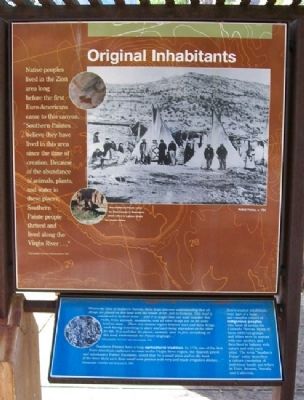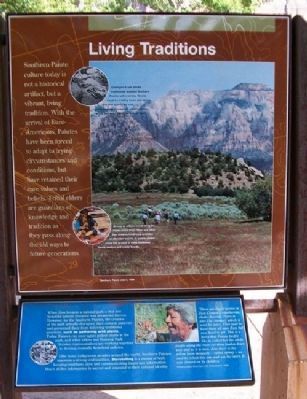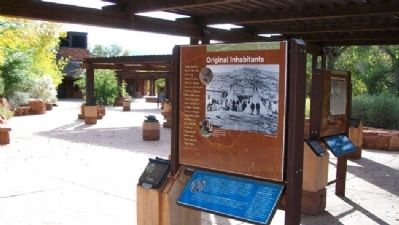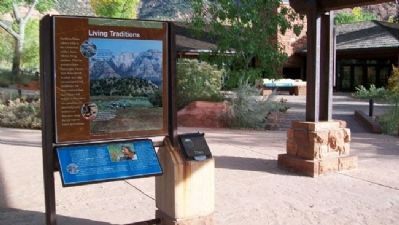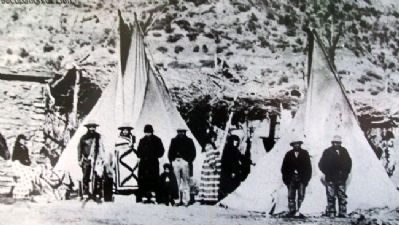Zion National Park in Washington County, Utah — The American Mountains (Southwest)
Original Inhabitants / Living Traditions
Original Inhabitants
Native peoples lived in the Zion area long before the first Euro-Americans came to this canyon. "Southern Paiutes believe they have lived in this area since the time of creation. Because of the abundance of animals, plants, and water in these places, Southern Paiute people thrived and lived along the Virgin River..."
Ethnographic Overview and Assessment, 1995
[Blue marker below]
"Within the lives of Southern Paiutes, there is an inherent understanding that all things are placed on this land with the breath of life, just as humans. This land is considered to be their home...and it is taught that one must consider that rocks, trees, animals, mountains, and all other things are on the same level as man...There is a mutual regard between man and these things, each having something to share and each being dependent on the other for life. It is said that the plants, animals, and, in fact, everything on this land, understands the Paiute language..."
Ethnographic Overview and Assessment, 1995
Southern Paiutes have a long agricultural tradition. In 1776, one of the first Euro-American explorers to come to the Virgin River region, the Spanish priest and missionary Father Escalante, noted that "in a small plain and on the bank of the river, there were three small corn patches with very well made irrigation ditches...
Ethnographic Overview and Assessment, 1995
Zion's original inhabitants were part of a large and complex culture of indigenous peoples who lived all across the Colorado Plateau. Many of these different groups and tribes were in contact with one another, and they lived in balance with nature and with each other. The term "Southern Paiute" today describes a culture consisting of individual bands and tribes in Utah, Arizon, Nevada, and California.
Living Traditions
Southern Paiute culture today is not a historical artifact, but a vibrant, living tradition. With the arrival of Euro-Americans, Paiutes have been forced to adapt to trying circumstances and conditions, but have retained their core values and beliefs. Tribal elders are guardians of knowledge and tradition as they pass along the old ways to future generations.
[Photo inset caption]
Groves of willows found along the banks of the Virgin River and other Zion streams historically provided an abundant source of supple, pliable wood that is used to make traditional Paiute baskets and cradle boards.
[Photo inset caption]
Oawingwa's oak shrubs traditionally supplied Southern Paiutes with a strong, flexible wood for crafting bows and arrows, and with acorns for food. Contemporary Paiutes still collect acorns, which they grind into flour, boil, or roast.
[Blue marker below]
When Zion became a national park a vital and beautiful natural resource was preserved forever. However, for the Southern Paiutes, the creation of the park actually disrupted their cultural patterns and prevented them from following traditional practices, such as gathering wild plants. Today, Paiutes can once again gather plants in the park, and tribal elders and National Park Service representatives are working together to develop mutually beneficial policies.
Like many indigenous peoples around the world, Southern Paiutes maintain a strong oral tradition. Storytelling is a means of both keeping traditions alive and communicating important information. Much of this information is sacred and essential to their cultural identity.
Erected by National Park Service.
Topics and series. This historical marker is listed in these topic lists: Agriculture • Environment • Native Americans. In addition, it is included in the Dominguez y Escalante Expedition series list. A significant historical year for this entry is 1995.
Location. 37° 12.025′ N, 112° 59.234′ W. Marker is in Zion National Park, Utah, in Washington County. Marker is under the northernmost open-sided pavilion on the
plaza west adjacent to the Zion National Park Visitor Center (near the south park entrance). Touch for map. Marker is in this post office area: Springdale UT 84767, United States of America. Touch for directions.
Other nearby markers. At least 8 other markers are within 6 miles of this marker, measured as the crow flies. Promised Land (within shouting distance of this marker); Westward Expansion (within shouting distance of this marker); Birth of a Park (within shouting distance of this marker); Stephen Tyng Mather (approx. ¾ mile away); Discovery of Zion Canyon (approx. one mile away); Zion Mt. Carmel Tunnel and Highway, Utah (approx. 1.4 miles away); Rockville Bridge (approx. 4 miles away); Cables from the Rim (approx. 5½ miles away). Touch for a list and map of all markers in Zion National Park.
Also see . . .
1. Zion National Park. (Submitted on February 21, 2011, by William Fischer, Jr. of Scranton, Pennsylvania.)
2. Paiute Indian Tribe of Utah. (Submitted on February 21, 2011, by William Fischer, Jr. of Scranton, Pennsylvania.)
Credits. This page was last revised on October 14, 2020. It was originally submitted on February 21, 2011, by William Fischer, Jr. of Scranton, Pennsylvania. This page has been viewed 769 times since then and 11 times this year. Photos: 1, 2, 3, 4, 5. submitted on February 21, 2011, by William Fischer, Jr. of Scranton, Pennsylvania.
